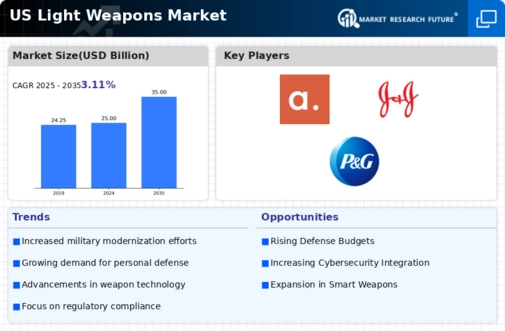Civilian Market Expansion
The light weapons market is also witnessing significant growth in the civilian sector, driven by an increasing interest in personal defense and recreational shooting. Recent surveys indicate that approximately 30% of US households own firearms, with a notable preference for lightweight and easily maneuverable weapons. This trend is further supported by the rising popularity of shooting sports and hunting activities, which have seen participation rates increase by around 15% in recent years. As more individuals seek to acquire light weapons for self-defense and leisure, manufacturers are likely to expand their product lines to cater to this burgeoning market. Additionally, the influence of social media and online platforms in promoting firearm ownership and education may further stimulate demand within the light weapons market, creating opportunities for growth and innovation.
Evolving Security Threats
The light weapons market is significantly influenced by the evolving security landscape in the US. Heightened concerns regarding domestic and international threats have prompted both government and civilian sectors to prioritize personal and national security. The rise in violent crime rates in certain urban areas has led to increased demand for personal defense weapons among civilians. Simultaneously, military and law enforcement agencies are seeking to enhance their operational capabilities in response to potential threats. This dual demand creates a dynamic environment for the light weapons market, as manufacturers are compelled to innovate and provide solutions that address these security challenges. The anticipated growth in demand for reliable and effective light weapons is likely to drive investments and research in this sector, fostering a competitive market landscape.
Rising Military Expenditure
The light weapons market in the US is experiencing a notable surge due to increasing military expenditure. The US government has allocated substantial budgets for defense, with a projected increase of approximately 5% annually over the next five years. This financial commitment is likely to enhance procurement of advanced light weapons, including rifles and handguns, which are essential for modern warfare. The emphasis on upgrading military capabilities, particularly in light of evolving global threats, suggests a robust demand for innovative weaponry. Furthermore, the focus on enhancing soldier survivability and effectiveness in combat scenarios drives investments in lightweight and versatile weapon systems. As a result, the light weapons market is poised for growth, with manufacturers expected to respond to the heightened demand by developing cutting-edge technologies that meet the needs of the armed forces.
Legislative and Policy Developments
Legislative changes and policy developments play a crucial role in shaping the light weapons market. Recent discussions surrounding gun control measures and regulations have sparked debates that could impact the market dynamics. While some states are enacting stricter regulations, others are moving towards more permissive laws, creating a complex regulatory environment. This variability may influence consumer behavior and purchasing decisions, as individuals navigate the legal landscape surrounding firearm ownership. Additionally, manufacturers must adapt to these changes by ensuring compliance with evolving regulations while also addressing consumer preferences for safety and security. The light weapons market is likely to experience fluctuations in demand as these legislative developments unfold, necessitating strategic responses from stakeholders to remain competitive and responsive to market needs.
Technological Integration in Weaponry
The integration of advanced technologies into weapon systems is a pivotal driver for the light weapons market. Innovations such as smart targeting systems, enhanced optics, and modular designs are becoming increasingly prevalent. These advancements not only improve accuracy and user experience but also align with the military's need for adaptable and efficient weaponry. The US military has been investing heavily in research and development, with an estimated $1.5 billion allocated for technology integration in light weapons over the next few years. This focus on modernization is likely to influence civilian markets as well, as consumers seek the latest features and enhancements in their firearms. Consequently, the light weapons market is expected to evolve rapidly, with manufacturers striving to incorporate cutting-edge technologies that meet both military and civilian demands.














Leave a Comment